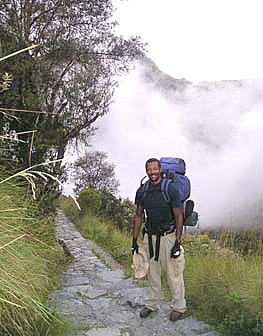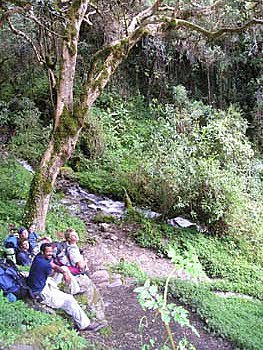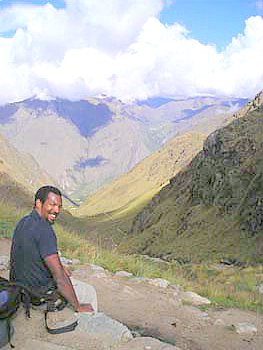The Inca Trail to Machu Picchu, Peru (4/6/04 - 4/9/04)

Inca Trail, Peru

In your best Valley Girl voice: “That makes sense. It’s a 27 mile trek. He’s got 40 pounds strapped to his back. Why NOT numb the body? But why is he putting it in his MOUTH?!?”
This was the thought process of one of my students when she thought I was putting cocaine in my mouth. I had just jokingly responded to another question answering, “The coca leaves weren’t strong enough, so I decided to go for the real thing.”
Tells you a little about my students and their backgrounds, huh? I look forward to the day that I’ll be leading less fortunate youth…
The white powder I was putting in my mouth with the coca leaves was baking powder.
The coca leaves that much of South America drinks as tea is akin to the larger leaves that are used to make cocaine. However, neither these small leaves nor the larger ones become cocaine until they undergo an extensive process involving gasoline, fermentation, and distilleries (among other things).
Coca leaves have many medicinal properties. Taken as a tea with no additives it is good to help combat the effects of altitude sickness. Add sugar to the tea, and it helps deal with stomach issues. Pack the leaves with a little baking powder between the gum and cheek and it helps combat fatigue and hunger much in the same way that caffeine from coffee or soda does, but without causing as much physiological damage.
Another comment from one of my students that made me smile was “This is a challenging hike! MY challenge is letting Dave carry all my stuff.”
But enough about my students and coca leaves. You want to hear about the hike, right?”
Four days of steamy jungles with moss covered trees, cold and windy mountain passes 12,000 feet above sea level, distant waterfalls spanning hundreds of meters, exotic birds and jungle sounds, and countless steps made the hike of the Inca Trail to the “Mysterious Lost City of the Incas” an unforgettable experience.

Early on Day 2, Inca Trail, Peru

The first day wasn’t all that impressive. My first thoughts were “I don’t remember anyone mentioning that there were cows on the Inca Trail.” But there were cows. And donkeys. And cow and donkey dung. As well as numerous campesinos (farmers or “country folk”) selling water, Gatorade, chocolate and fruit along the way. We started the day at an elevation of 8,528 feet.
It took us 4 hours to hike 7.5 miles to our campsite which was at 9,840 feet. The most impressive sight of the day was the sunset view of the distant snowy peak of Veronica standing at an elevation of 20,000 feet.
Before I continue I must give props to the porters. These are native Peruvians carrying 50 pounds of camping gear (propane tanks, tables, etc) without the luxury of fancy backpacks or hiking boots. They break down the campsite AFTER we leave, pass us on the trail (as they are RUNNING! In flip flops, no less!), and set up our camp and cook lunch and dinner BEFORE we arrive! Watching these cats brought to mind those Mastercard commercials:
“Hiking 27 miles with 40 pounds on your back: a pain in the back.
Having to wait for slow hikers in the group: a pain in the @$$.
Having porters carry all the real heavy stuff AND set up your camp and cook your meals: PRICELESS!”
I’m surprised that Nike or Northface hasn’t made it to Peru to outfit these guys and make commercials.
The 2nd day was a beast. Gone were the cow, donkeys and campesinos. They were replaced by a fierce incline and THOUSANDS of steps. We only hiked 6 miles, but since the majority of the hike was a steep incline that rose 4,000 vertical feet, it took us 5 hours to make it from our first campsite to the mountain pass called Dead Woman’s Pass, 13,776 feet above sea level. This was by far the most intense (and longest) quad and calf workout I have ever experienced. You know how sports announcers are always making a big deal of the thin air that sea level athletes have to contend with when they play in the Mile High City of Denver, CO? Well, to put things in perspective, Denver is at less than 6,000 feet above sea level.

Dead Woman's Pass, Inca Trail, Peru

As proof that the descent is much easier for me than the ascent (surprisingly not true for everyone), Dave (the other athlete of the group) and I descended the final 2,300 feet to the campsite in 30 minutes.
In By the River Piedra I Sat and Wept Paulo Coelho (author of The Alchemist, one of my favorite books) talks about God’s feminine face/energy being present whenever water is. As my legs burned from the continuous climbing and my lungs begged for the scarce oxygen in that thin air, I certainly felt nurtured by the streams that trickled silently across the trail in 6 inch wide channels, encouraged by rivers that roared violently alongside the trail or under footbridges that we crossed, and embraced (hugged) by the clouds that we climbed above and descended into.
On the first day I had a nasty sore throat that I was worried would turn into a cold (most likely from the smoke filled bars and clubs I visited while in Cusco the 2 days before the hike). Some people say humidity can make you sick, in such cases it may be divine energy telling you to slow down and take care of yourself. Granted, a part of the 40 pounds I was carrying were fruits and vegetables that I ate every time we took a break (because mom and dad taught me that live foods help the body combat invading maladies), but despite the intense workout of the 2nd day, and the fact that we camped in the cold that night, I felt better at the end of the 2nd day than I did at the start of the first…
There were many beautiful sites on day 2, but the most impressive for me were the constantly changing weather patterns in the valley where we camped. You could see the clouds roll in. Then we were in the midst of a light fog. Then it rained a little. All of a sudden a bit of sun would break through to shine on the mountains in the distance… all in the waning minutes of the day.

El Camino Inca, Peru

The 3rd day was pretty beastly too. Though we crossed 2 more mountain passes (12,792 ft, and 11,972 ft. respectively) there was much less climbing as the trail was tempered with level parts and descents. What made this day so challenging was the rain that fell incessantly for the first 4 hours of the day. I couldn’t tell if my “waterproof & breathable” rain jacket had failed because it let in water or because it didn’t let enough heat escape, but by time we reached the campsite for lunch I was soaking wet either from water or sweat. Luckily, the waterproof cover for my backpack worked like a champ and kept my sleeping bag and warm clothes dry so that I didn’t have a miserable night. We hiked 10 miles on the third day in 7 hours.
Finally, after 2 hours of hiking on the 4th day, Dave and I were the first to reach our destination, the ancient Inca city of Machu Picchu. It was built some time during the reign of the Incas (12th to 15th centuries), and was a city replete with temples, a main square, and farming and urban districts.

Machu Picchu & Huayna Picchu from the Sun Gate


Machu Picchu & Huayna Picchu, Peru


Machu Picchu, Peru

There are numerous books with various theories as to what the site could have been, but Machu Picchu is shrouded in mystery because no one knows for sure what purpose the site served. Eighty percent of the mummies found there were women. Was it a nunnery? A brothel? Some kind of stronghold? The king’s villa? Again, no one knows for sure, but our guide went with the villa theory. She thinks that the women there were the “chosen” women who were privileged enough to make the king’s garments and tapestries, but she invited us to come up with our own theories. Since Machu Picchu was somewhat isolated and hard to get to, it is considered a relatively safe city. I think it was the location at which warriors left their women for safekeeping when they went off to expand the Incan empire.
Since the site is located between 2 mountain peaks exactly due north and due south of the ancient city, and it is aligned with the stars (there’s that pre-Columbus transoceanic influence again), many historians and others believe that it is a place of considerable cosmic energy. I can’t say that I had an experience similar to the one I had in the salt plains of Bolivia, but I can tell you that I expected to be ready for an afternoon nap after 4 days of hiking (I am NOT a hiker). Instead, after waiting 1.5 hours for the rest of the group to arrive, I climbed 45 minutes to the top of Huayna Picchu (the peak to the south) for another perspective of Machu Picchu. The hike was a scramble nearly straight up (a vertical distance of 1,000 feet), but those of us who braved it were able to enter Pachamama’s womb and be born again.

Machu Picchu from Huayna Picchu, Peru

Pachamama is Mother Earth, and the Incas believed that the small tunnel and tiny cavern it lead to were symbolic of her birth canal and womb. When I came out of the other side our guide said that I was now indigenous, like him. After completing a 27 mile 4 day hike with 40 pounds on my back (only 10 less than the legal limit porters were allowed to carry) AND climbing Huayna Picchu, I felt like I could have been the incarnation of an Incan warrior. :)

Inca Trail Tunnel, Peru



0 Comments:
Post a Comment
<< Home